Overpressure Generation Mechanisms and Its Distribution in the Paleocene Shahejie Formation in the Linnan Sag, Huimin Depression, Eastern China
Abstract
1. Introduction
2. Geological Setting
3. Data and Methods
3.1. DST Data Selection
3.2. Well Log and Compaction Curve
3.3. Mud Weight and Equivalent Pressure
4. Pressure Characteristics and Origins of Overpressure
4.1. Pressures in Reservoirs
4.2. Pressures in Mudstones
4.3. Correspondence of Pressures between Reservoirs and Adjacent Mudstones
4.4. Identifying the Overpressuring Mechanisms
5. Discussion
5.1. Establishing a Reliable Mudstone Compaction Curve
5.2. Mechanisms of Overpressuring
5.2.1. Mudstone Disequilibrium Compaction
5.2.2. Maturation of Organic Matter
5.2.3. Overpressure Vertical Transfer
5.3. Cause of the Difference between the Mudstone and Reservoir Pressures
5.4. Implications for Oil Accumulation and Exploration
6. Conclusions
- (1)
- The sedimentary facies considerably vary in continental basins, and it is often difficult to maintain similar mudstone compaction trends in different layers because of factors such as lithology, mineral composition, faults, and unconformities. The compaction curves are too scattered to determine the normal compaction trend and the top of the disequilibrium compaction zone, to identify the overpressure mechanisms and estimate pressures. Studies on mudstone compaction, must eliminate these non-compaction factors as much as possible. Reliable mudstone compaction curves and loading curves are essential to the accuracy of overpressure origins identification and the estimated overpressure estimation.
- (2)
- The pressures in Es1 and Es2 are normal, and clear overpressure zones occur primarily in the Es3 and Es4 intervals. The maximum pressure gradients in Es3 and Es4 are 16.2 and 14.3 MPa/km, respectively, and the maximum overpressures are approximately 24 and 14 MPa, respectively. The overpressures in the mudstones increase with depth and decrease gradually from the center of the sag to the margins, and they approach hydrostatic pressure in the uplift. The differences in the sealing conditions cause the coexistence of abnormal and normal pressures at similar depths, and the origin and preservation conditions of overpressure result in discrepancies between the reservoir and mudstone pressures.
- (3)
- Mudstone disequilibrium compaction is the fundamental mechanism that generates overpressure, and the overpressured points follow the loading curve in the acoustic velocity/density–vertical effective stress and acoustic velocity–density crossplots. Due to the low TOC and low maturity, hydrocarbon generation is speculated to play a minor role in overpressure generation in the Linnan Sag. Vertical transfer may be the main unloading mechanism and is manifested as overpressure points that deviate from the loading curves. The transfer of overpressure through opening faults is likely the main cause of higher overpressure in local sandstones.
Author Contributions
Funding
Acknowledgments
Conflicts of Interest
References
- Hao, F.; Zou, H.Y.; Gong, Z.S.; Yang, S.G.; Zeng, Z.P. Hierarchies of overpressure retardation of organic matter maturation: Case studies from petroleum basins in China. AAPG Bull. 2007, 91, 1467–1498. [Google Scholar] [CrossRef]
- Luo, X.R.; Vasseur, G. Natural hydraulic cracking: Numerical model and sensitivity study. Earth Planet. Sci. Lett. 2002, 201, 431–446. [Google Scholar] [CrossRef]
- Stricker, S.; Jones, S.J.; Sathar, S.; Bowen, L.; Oxtoby, N. Exceptional reservoir quality in HPHT reservoir settings: Examples from the Skagerrak Formation of the Heron Cluster, North Sea, UK. Mar. Pet. Geol. 2016, 77, 198–215. [Google Scholar] [CrossRef]
- Tingay, M.R.P.; Morley, C.K.; Laird, A.; Limpornpipat, O.; Krisadasima, K.; Pabchanda, S.; Macintyre, H.R. Evidence for overpressure generation by kerogen –to-gas maturation in the northern Malay Basin. AAPG Bull. 2013, 97, 639–672. [Google Scholar] [CrossRef]
- Muggeridge, A.; Abacioglu, Y.; England, W.; Smalley, C. The rate of pressure dissipation from abnormally pressured compartments. AAPG Bull. 2005, 89, 61–80. [Google Scholar] [CrossRef]
- Najibi, A.R.; Ghafoori, M.; Lashkaripou, G.R.; Asef, M.R. Reservoir geomechanical modeling: In-situ stress, pore pressure, and mud design. J. Pet. Sci. Eng. 2017, 151, 31–39. [Google Scholar] [CrossRef]
- Shi, Y.L.; Wang, C.Y. Pore pressure generation in sedimentary basins: Overloading versus aquathermal. J. Geophys. Res. Solid Earth Planets 1986, 91, 2153–2162. [Google Scholar] [CrossRef]
- Luo, X.R.; Vasseur, G. Contributions of compaction and aquathermal pressuring to geopressure and the influence of environmental conditions. AAPG Bull. 1992, 76, 1550–1559. [Google Scholar]
- Osborne, M.J.; Swarbrick, R.E. Mechanisms for generating overpressure in sedimentary basins: A reevaluation. AAPG Bull. 1997, 81, 1023–1041. [Google Scholar]
- Wangen, M. A quantitative comparison of some mechanisms generating overpressure in sedimentary basins. Tectonophysics 2001, 334, 211–234. [Google Scholar] [CrossRef]
- Tingay, M.R.P.; Hillis, R.R.; Swarbrick, R.E.; Morley, C.K.; Damit, A.R. Origin of overpressure and pore-pressure prediction in the Baram province, Brunei. AAPG Bull. 2009, 93, 51–74. [Google Scholar] [CrossRef]
- Luo, X.R.; Vasseur, G. Overpressure dissipation mechanisms in sedimentary sections consisting of alternating mud-sand layers. Mar. Pet. Geol. 2016, 78, 883–894. [Google Scholar] [CrossRef]
- Luo, X.R.; Yang, J.H.; Wang, Z.F. The overpressuring mechanisms in aquifers and pressure prediction in basins. Geol. Rev. 2000, 46, 22–31. [Google Scholar]
- Luo, X.R.; Vasseur, G. Geopressuring mechanism of organic matter cracking: Numerical modeling. Bull. Am. Assoc. Pet. Geol. 1996, 80, 856–874. [Google Scholar]
- Swarbrick, R.E.; Osborne, M.J.; Yardley, G.S. Comparison of overpressure magnitude resulting from the main generating mechanisms. In Pressure Regimes in Sedimentary Basins and Their Prediction; Huffman, A., Bowers, G., Eds.; AAPG Memoir 76: Tulsa, OK, USA, 2002; pp. 1–12. [Google Scholar]
- Law, B.E.; Spencer, C.W. Abnormal pressures in hydrocarbon environments. In Abnormal Pressures in Hydrocarbon Environments; Law, B.E., Ulmishek, G.F., Slavin, V.I., Eds.; AAPG Memoir 70: Tulsa, OK, USA, 1998; pp. 1–11. [Google Scholar]
- Ruth, P.V.; Hillis, R.; Tingate, P. The origin of overpressure in the Carnarvon Basin, western Australia: Implications for pore-pressure prediction. Pet. Geosci. 2004, 10, 247–257. [Google Scholar] [CrossRef]
- Swarbrick, R.E.; Osborne, M.J. Mechanisms that generate abnormal pressures: An overview. In Abnormal Pressures in Hydrocarbon Environments; Law, B.E., Ulmishek, G.F., Slavin, V.I., Eds.; AAPG Memoir 70: Tulsa, OK, USA, 1998; pp. 13–34. [Google Scholar]
- Magara, K. Compaction and Fluid Migration: Practical Petroleum Geology; Elsevier Science: Amsterdam, The Nederland, 1978; pp. 1–215. [Google Scholar]
- Bowers, G.L. Detecting High Overpressure. Lead. Edge 2002, 21, 174–177. [Google Scholar] [CrossRef]
- Zhang, J.C. Pore pressure prediction from well logs: Methods, modifications, and new approaches. Earth Sci. Rev. 2011, 108, 50–63. [Google Scholar] [CrossRef]
- Bowers, G.L. Pore pressure estimation from velocity data: Accounting for overpressure mechanisms besides undercompaction. SPE Drill. Complet. 1995, 10, 89–95. [Google Scholar]
- Hermanrud, C.; Wensaas, L.; Teige, G.M.G.; Nordgård, H.M.; Hansen, S.; Vik, E. Shale porosities from well logs on Haltenbanken (Offshore Mid-Norway) show no influence of overpressuring. In Abnormal Pressures in Hydrocarbon Environments; Law, B.E., Ulmishek, G.F., Slavin, V.I., Eds.; AAPG Memoir 70: Tulsa, OK, USA, 1998; pp. 65–85. [Google Scholar]
- Bowers, G.L.; Katsube, T.J. The role of shale pore structure on the sensitivity of wire-line logs to overpressure. In Pressure Regimes in Sedimentary Basins and Their Prediction; Huffman, A., Bowers, G., Eds.; AAPG Memoir 76: Tulsa, OK, USA, 2002; pp. 43–60. [Google Scholar]
- Zhang, J.C. Effective stress, porosity, velocity and abnormal pore pressure prediction accounting for compaction disequilibrium and unloading. Mar. Pet. Geol. 2013, 45, 2–11. [Google Scholar] [CrossRef]
- Lahann, R.W. Gulf of Mexico overpressure and clay diagenesis without unloading: An anomaly? AAPG Bull. 2017, 101, 1859–1877. [Google Scholar] [CrossRef]
- Swarbrick, R.E. Review of pore-pressure prediction challenges in high-temperature areas. Lead. Edge. 2012, 31, 1288–1294. [Google Scholar] [CrossRef]
- Dasgupta, S.; Chatterjee, R.; Mohanty, S.P. Magnitude, mechanisms and prediction of abnormal pore pressure using well data in the Krishna Godavari Basin, East coast of India. AAPG Bull. 2016, 100, 1833–1855. [Google Scholar] [CrossRef]
- Fan, C.Y.; Wang, Z.L.; Wang, A.G.; Fu, S.T.; Wang, L.Q.; Zhang, Y.S.; Kong, X.X.; Zhang, X. Identification and calculation of transfer overpressure in the northern Qaidam Basin, northwest China. AAPG Bull. 2016, 100, 23–39. [Google Scholar] [CrossRef]
- Tingay, M.R.P.; Hillis, R.R.; Swarbrick, R.E.; Morley, C.K.; Damit, A.R. Vertically transferred overpressures in Brunei: Evidence for a new mechanism for the formation of high-magnitude overpressure. Geology 2007, 35, 1023–1026. [Google Scholar] [CrossRef]
- Swarbrick, R.E. Challenges of Porosity-Based Pore Pressure Prediction. In Proceedings of the 63rd EAGE Conference & Exhibition, Amsterdam, The Nederlands, 11–15 June 2001. [Google Scholar]
- Aplin, A.C.; Yang, Y.L.; Hansen, S. Assessment of β the compression coefficient of mudstones and its relationship with detailed lithology. Mar. Petr. Geol. 1995, 12, 955–963. [Google Scholar] [CrossRef]
- Zhang, F.Q.; Wang, Z.L.; Wu, Y.S.; Yang, J.H.; Luo, X.R. A method for eliminating geology factors of affecting compaction trendline. Acta Sedimentol. Sin. 2002, 20, 326–332. [Google Scholar]
- Mondol, N.H.; Bjørlykke, K.; Jahren, J.; Høeg, K. Experimental mechanical compaction of clay mineral aggregates—Changes in physical properties of mudstones during burial. Mar. Pet. Geol. 2007, 24, 289–311. [Google Scholar] [CrossRef]
- Li, C.; Zhang, L.K.; Luo, X.R.; Zhang, L.Q.; Hu, C.Z.; Qi, Y.K.; Lei, Y.H.; Cao, B.F.; Cheng, M.; Yu, Y.X. Calibration of the mudrock compaction curve by eliminating the effect of organic matter in organic-rich shales: Application to the southern Ordos Basin, China. Mar. Petr. Geol. 2017, 86, 620–635. [Google Scholar] [CrossRef]
- Chen, H.L.; Luo, X.R. Study of mudstone compaction curves and analysis of migration conditions of oil and gas. Oil Gas Geol. 1987, 8, 233–242. [Google Scholar]
- Luo, X.R.; Dong, W.L.; Yang, J.H.; Yang, W. Overpressuring mechanisms in the Yinggehai Basin, South China Sea. AAPG Bull. 2003, 87, 629–645. [Google Scholar] [CrossRef]
- Zhu, Z.Q.; Zeng, J.H.; Wang, J.J. Hydrocarbon migration characteristics of Linnan Sag in Huimin Depression. J. Southwest Pet. Univ. (Sci. Technol. Ed.) 2010, 32, 33–38. [Google Scholar]
- Wang, Y.S.; Qiu, Y.B. Overpressure structure dissimilarity and its controlling factors in the Jiyang Depression. Oil Gas Geol. 2017, 38, 430–437. [Google Scholar]
- Wang, B.; Zhang, L.K.; Li, C.; Chen, K.Y.; Song, G.Q.; Luo, H.M. Mechanism and distribution prediction of abnormal high pressure of the Paleocene Shahejie Formation in Linnan Sag, Huimin Depression. Oil Gas Geol. 2018, 39, 641–652. [Google Scholar]
- Liu, H.M. Hydrocarbon Migration and Accumulation Direction and Distribution of Linnan Sag in Jiyang Depression. Geoscience 2009, 23, 894–901. [Google Scholar]
- Liu, X.F. Distribution and origin of the abnormal pressure in a transtensional basin: A case study from Linan Subsag, Humin Sag. Geolo. Sci. Technol. Inf. 2011, 30, 1–4. [Google Scholar]
- Li, C.Q.; Liu, H.M. Abnormal formation pressure and its evolution features of the third member, Shahejie Formation, Linnan Sag. Earth Sci. J. China Univ. Geosci. 2013, 38, 105–111. [Google Scholar]
- Guo, X.W.; He, S.; Liu, K.Y.; Song, G.Q.; Wang, X.J.; Shi, W.Z. Oil generation as the dominant overpressure mechanism in the Cenozoic Dongying depression, Bohai Bay Basin, China. AAPG Bull. 2010, 94, 1859–1881. [Google Scholar] [CrossRef]
- Wang, B.J.; He, S.; Song, G.Q.; Wang, Y.S.; Wang, X.J.; Hao, X.F.; Luo, S.Y. Effective stress characteristics of different overpressured origins in Dongying Depression of the Bohai Bay Basin, China. Geol. Sci. Technol. Inf. 2012, 31, 72–79. [Google Scholar]
- He, S.; Song, G.Q.; Wang, Y.S.; Hao, X.F.; Wang, B.J.; Li, N.; Luo, S.Y. Distribution and Major Control Factors of the Present-Day Large-Scale Overpressured System in Dongying Depression. Earth Sci.-J. China Univ. Geosci. 2012, 37, 1029–1042. [Google Scholar]
- Chen, W.; Wu, Z.P.; Hou, F. Relationship between hydrocarbon accumulation and Linshang fault zone in Linnan area, Huimin depression. Pet. Geol. Recovery Effic. 2010, 17, 25–28. [Google Scholar]
- Wu, K.Y.; Zhao, Z.X.; Cui, S.L.; Li, J.Y. Controlling of Xiakou fault on hydrocarbon accumulation in the sourthern part of Huimin depression. J. Geomech. 2012, 18, 32–41. [Google Scholar]
- Feng, D.X.; Ye, F. Structure kinematics of a transtensional basin: An example from the Linnan Subsag, Bohai Bay Basin, eastern China. Geosci. Front. 2018, 9, 917–929. [Google Scholar] [CrossRef]
- Ni, J.L.; Guo, Y.; Wang, Z.M.; Liu, J.L.; Lin, Y.X.; Li, Y. Tectonics and Mechanisms of Uplift in the Central Uplift Belt of the Huimin Depression. J. Earth Sci. 2011, 22, 299–315. [Google Scholar] [CrossRef]
- Cao, Y.C.; Wang, S.J.; Wang, Y.Z.; Yang, T.; Zhang, S.M.; Zhang, H.N. Sedimentary characteristics and depositional model of slumping deep-water gravity flow deposits: A case study from the middle Member 3 of Paleogene Shahejie Formation in Linnan subsag, Bohai Bay Basin. J. Palaeogeogr. 2017, 19, 419–432. [Google Scholar]
- Guo, X.L.; Xiong, M.; Zhou, Q.; Tian, H.; Xiao, X.M. Petroleum generation and expulsion kinetics: A case study of the Shahejie formation source rocks from Linnan Sag of Huimin Depression. Acta Sedmentol. Sin. 2009, 27, 723–731. [Google Scholar]
- Li, Q.; Jiang, Z.X.; Liu, K.Y.; Zhang, C.M.; You, X.L. Factors controlling reservoir properties and hydrocarbon accumulation of lacustrine deep-water turbidites in the Huimin Depression, Bohai Bay Basin, East China. Mar. Pet. Geol. 2014, 57, 327–344. [Google Scholar] [CrossRef]
- Bredehoeft, J.D. The drill stem test—The petroleum industry’s deep-well pumping test. Ground Water 1965, 3, 31–36. [Google Scholar] [CrossRef]
- Carcione, J.M.; Helle, H.B.; Pham, N.H.; Toverud, T. Pore pressure estimation in reservoir rocks from seismic reflection data. Geophysics 2003, 68, 1569–1579. [Google Scholar] [CrossRef]
- Harrold, T.W.D. Porosity and Effective Stress Relationships in Mudrocks. Ph.D. dissertation, Durham University, Durham, England, 2001; pp. 31–35. [Google Scholar]
- Sayers, C.M.; Johnson, G.M.; Denyer, G. Predrill pore-pressure prediction using seismic data. Geophysics 2002, 67, 1286–1292. [Google Scholar] [CrossRef]
- Shaker, S.S. Causes of disparity between predicted and measured pore pressure. Lead. Edge 2002, 21, 756–760. [Google Scholar] [CrossRef]
- Sargent, C.; Goulty, N.R.; Cicchino, A.M.P.; Ramdhan, A.M. Budge–Fudge method of pore-pressure estimation from wireline logs with application to Cretaceous mudstones at Haltenbanken. Pet. Geosci. 2015, 21, 2014–2088. [Google Scholar] [CrossRef]
- Goulty, N.R.; Sargent, C.; Andras, P.; Aplin, A.C. Compaction of diagenetically altered mudstones—Part 1: Mechanical and chemical contributions. Mar. Pet. Geol. 2016, 77, 703–713. [Google Scholar] [CrossRef]
- Yang, Y.L.; Aplin, A.C. Definition and practical application of mudstone porosity-effective stress relationships. Pet. Geosci. 2004, 10, 153–162. [Google Scholar] [CrossRef]
- Hoesni, M.J. Origins of Overpressure in the Malay Basin and Its Influence on Petroleum Systems. Ph.D. dissertation, Durham University, Durham, UK, 2004; pp. 19–34. [Google Scholar]
- Marcussen, Ø.; Thyberg, B.I.; Peltonen, C.; Jahren, J.; Bjorlykke, K.; Faleide, J.I. Physical properties of Cenozoic mudstones from the northern North Sea: Impact of clay mineralogy on compaction trends. Bull. Am. Assoc. Pet. Geol. 2009, 93, 127–150. [Google Scholar] [CrossRef]
- Kalani, M.; Jahren, J.; Mondol, N.H.; Faleide, J.I. Compaction processes and rock properties in uplifted clay dominated units–the Egersund Basin, Norwegian North Sea. Mar. Pet. Geol. 2015, 68, 596–613. [Google Scholar] [CrossRef][Green Version]
- Ni, J.L.; Zhang, H.; Tang, X.L.; Han, S. Diagenetic and paleogeothermal evolution of the clay minerals in the Center Uplift Belt and its adjacent region of Huimin Sag, Jiyang Depression. Nat. Gas Geosci. 2016, 27, 1778–1788. [Google Scholar]
- Audet, D.M.; McConnell, J.D.C. Forward modeling of porosity and pore pressure evolution in sedimentary basins. Basin Res. 1992, 4, 147–162. [Google Scholar] [CrossRef]
- Luo, X.R.; Vasseur, G. Modeling of pore pressure evolution associated with sedimentation and uplift in sedimentary basins. Basin Res. 1995, 7, 35–52. [Google Scholar] [CrossRef]
- Liu, Z.Y. Dynamics System of Petroleum Accumulation in the Linnan Depression. In Ph.D. dissertation; Guangzhou Institute of Geochemistry, Chinese Academy of Sciences: Guangzhou, China, 2003; pp. 1–130. [Google Scholar]
- Yardley, G.S.; Swarbrick, R.E. Lateral transfer: A source of additional overpressure? Mar. Pet. Geol. 2000, 17, 523–537. [Google Scholar] [CrossRef]
- Grauls, D.J.; Baleix, J.M. Role of overpressures and in situ, stresses in fault-controlled hydrocarbon migration: A case study. Mar. Pet. Geol. 1994, 11, 734–742. [Google Scholar] [CrossRef]
- Luo, X.R. Allogenic overpressuring associated with faulting and geological consequences. Acta Geol. Sin. 2004, 78, 641–648. [Google Scholar]
- Si, X.Q. The Research of Conditions for Hydrocarbon Accumulation of Kongdian Formation in Huimin Depression. Ph.D. dissertation, Ocean University of China, Qingdao, China, 2008; pp. 124–129. [Google Scholar]
- Meng, Y.; Han, Z.Z. Fault sealing and difference between the east section and the west section of Xiakou fault. China Sci. Paper 2015, 10, 1066–1070. [Google Scholar]
- O’Connor, S.A.; Swarbrick, R.E.; Jones, D. Where has all the pressure gone? Evidence from pressure reversals and hydrodynamic flow. First Break 2008, 26, 55–61. [Google Scholar] [CrossRef]
- Chang, X.C. Formation Mechnism and Occurrences of Lithilogical Petroleum Reservoirs of Es3 in Linnan Subsag. Ph.D. dissertation, Shandong University of Science and Technology, Qingdao, China, 2007; pp. 38–91. [Google Scholar]
- Haney, M.M.; Snieder, R.; Sheiman, J.; Steven, L. A moving fluid pulse in a fault zone. Nature 2005, 437, 46. [Google Scholar] [CrossRef]
- Tian, Z.H. The Investigation of the Depositional System in Linnan Low-Laying Upper Es4 and the Evaluation of Exploration Potential. Ph.D. dissertation, Ocean University of China, Qingdao, China, 2007; pp. 1–116. [Google Scholar]
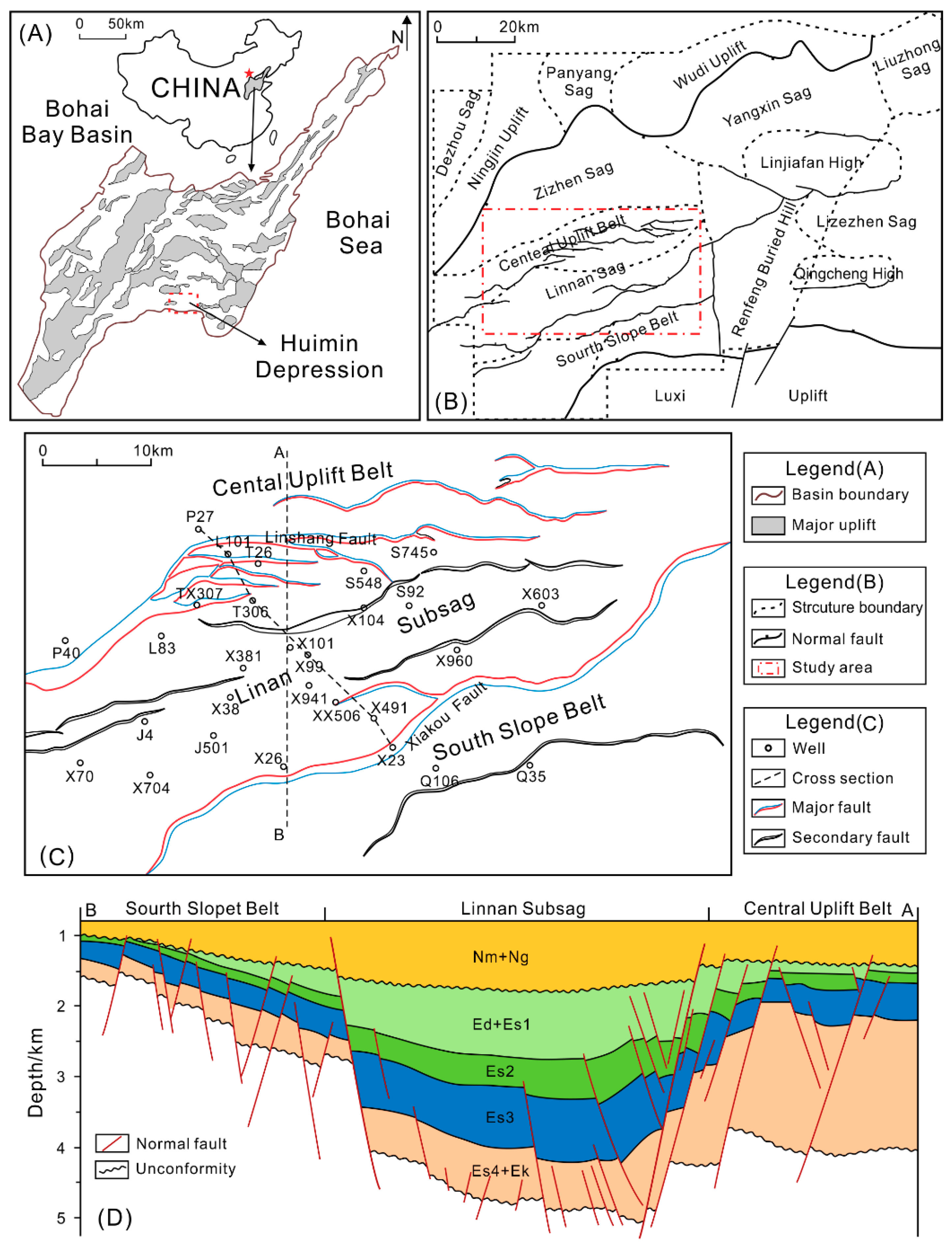


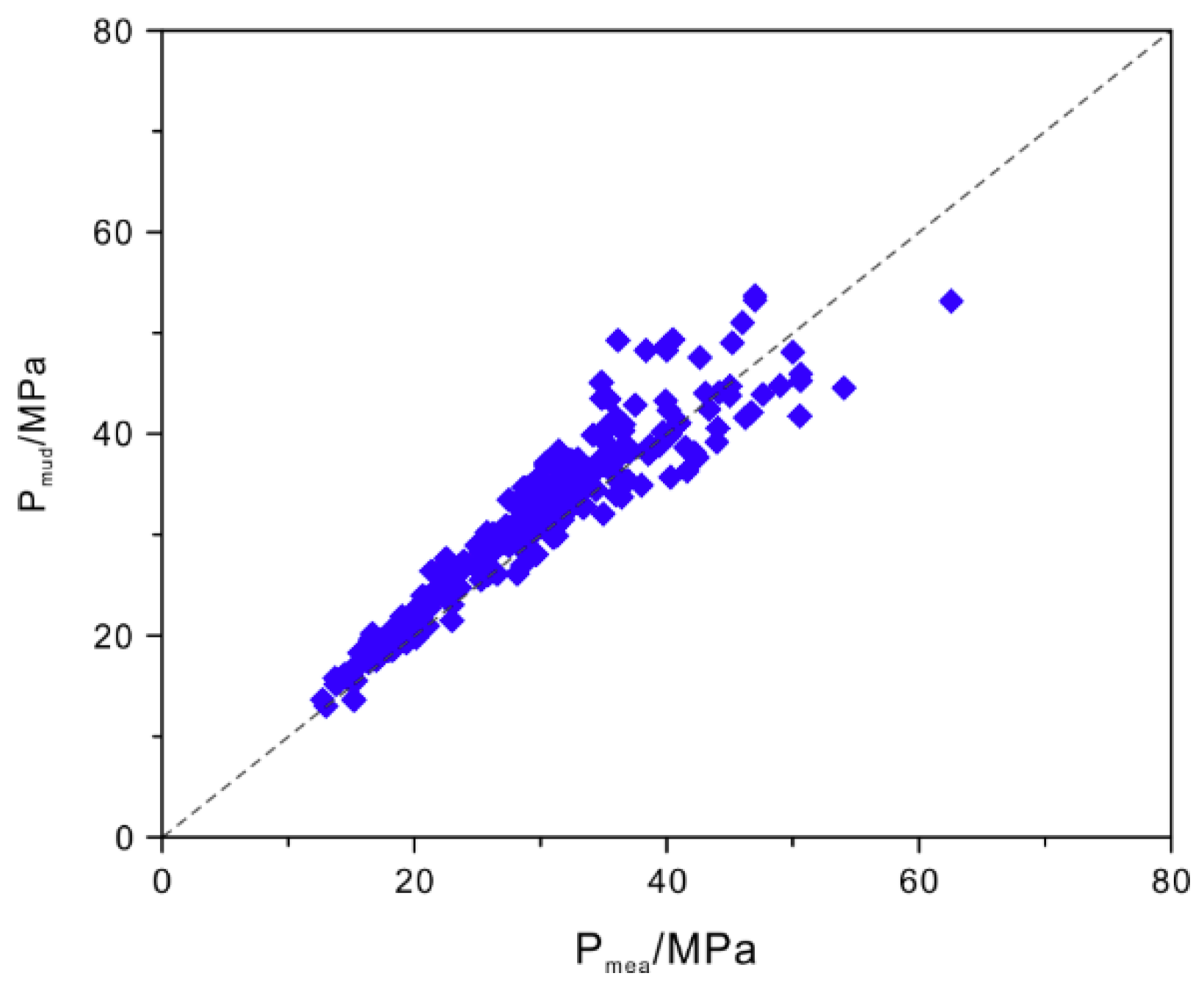


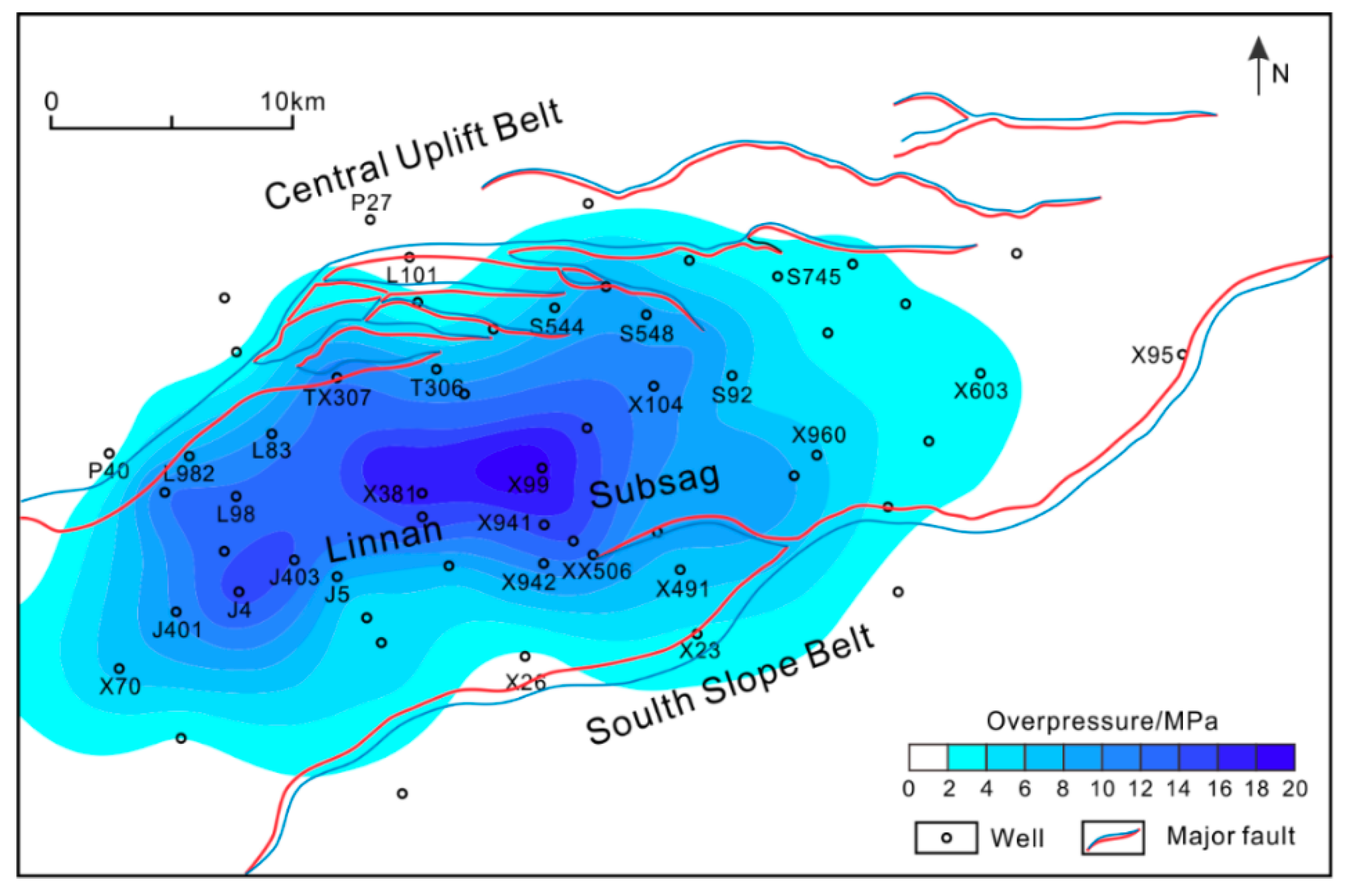

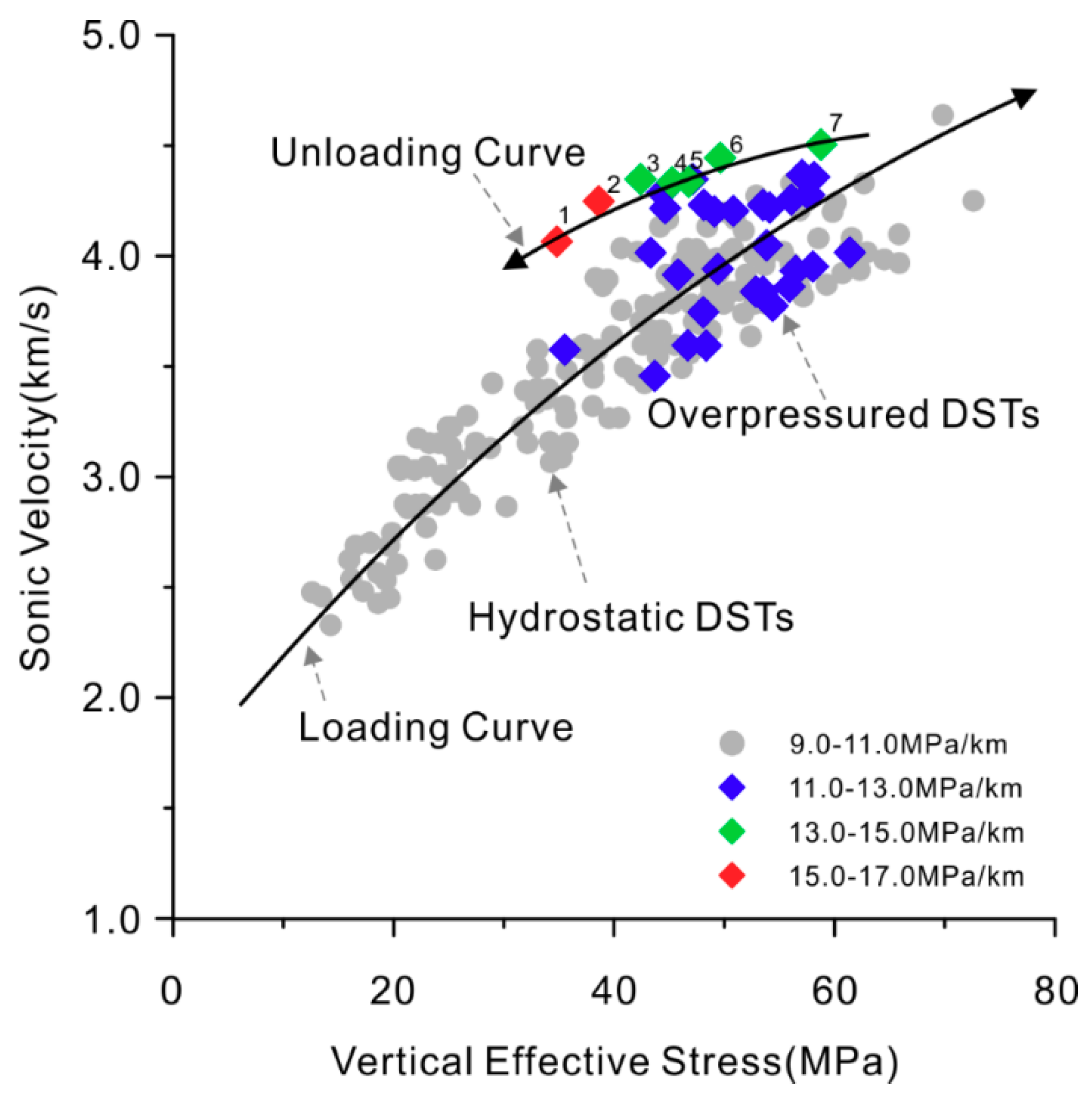

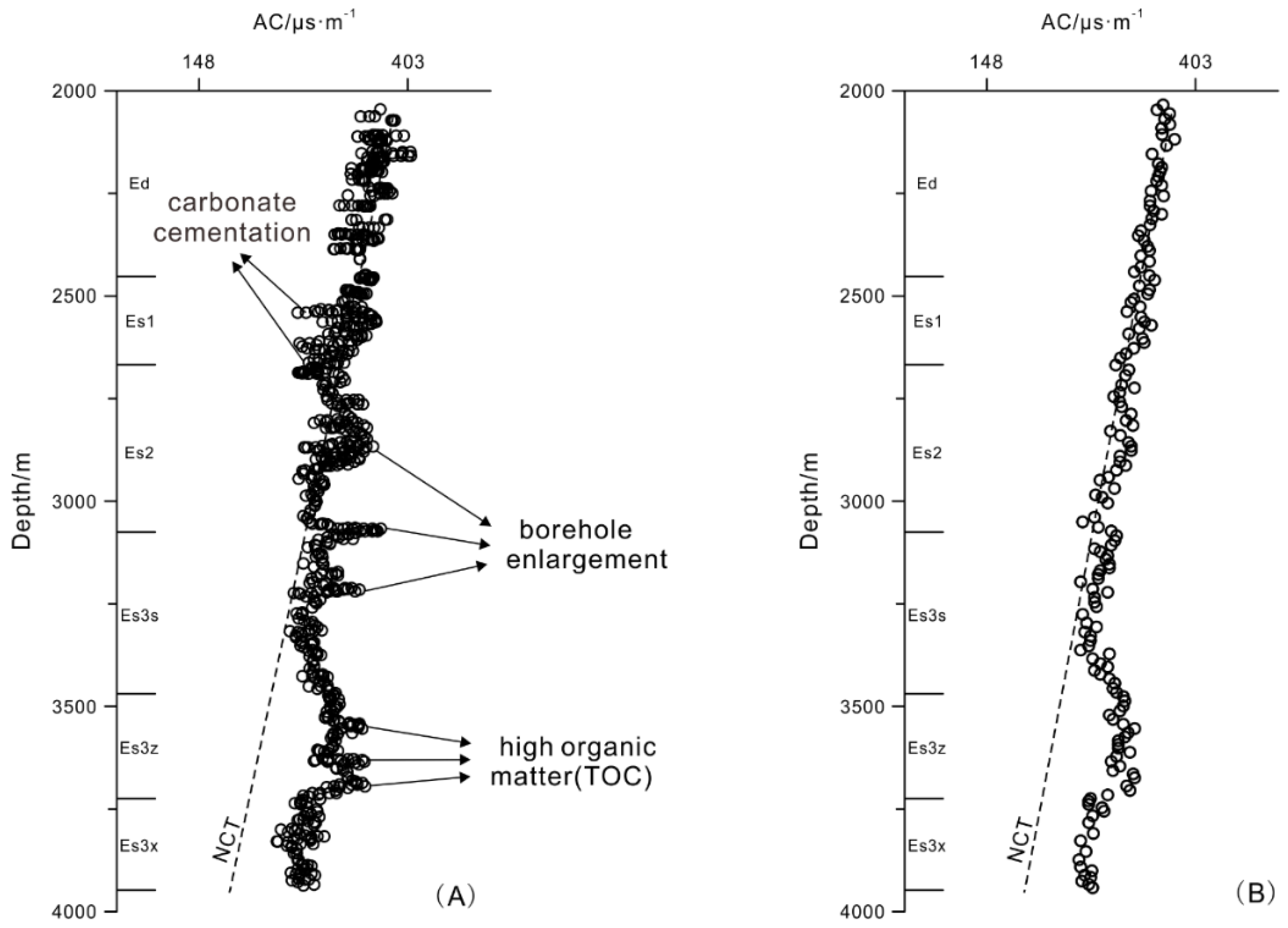
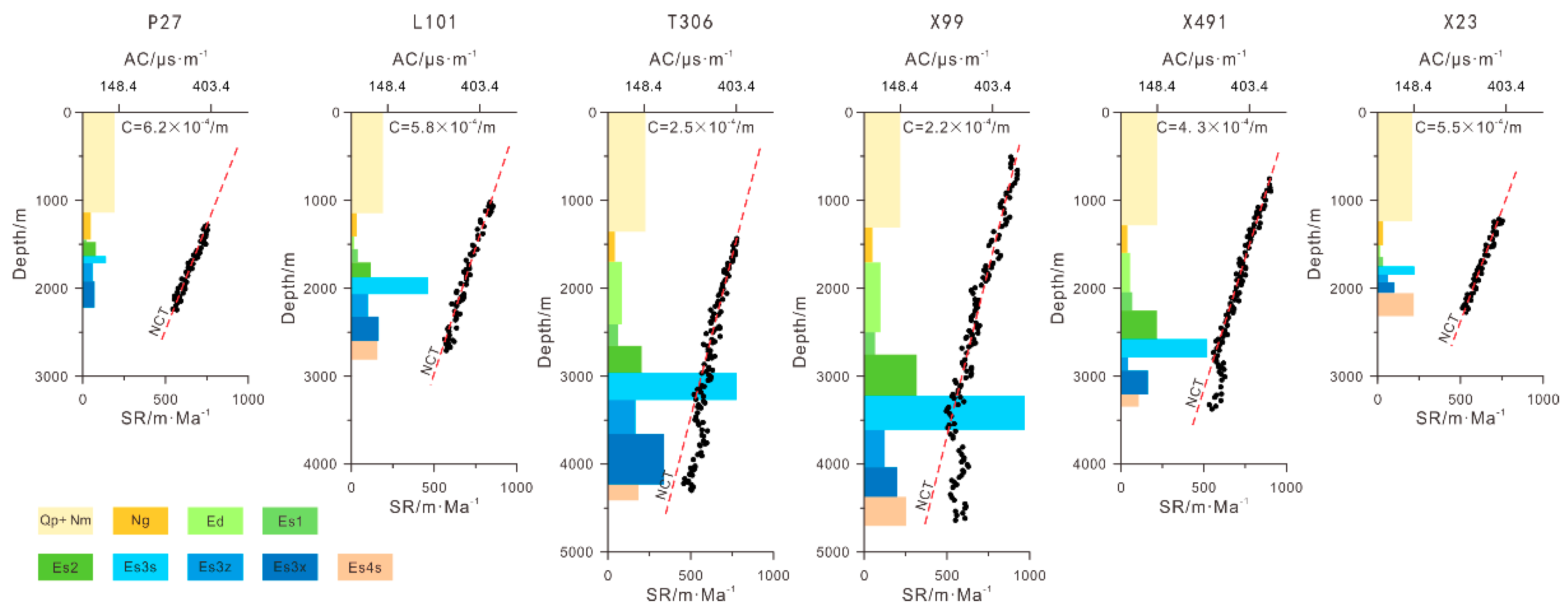


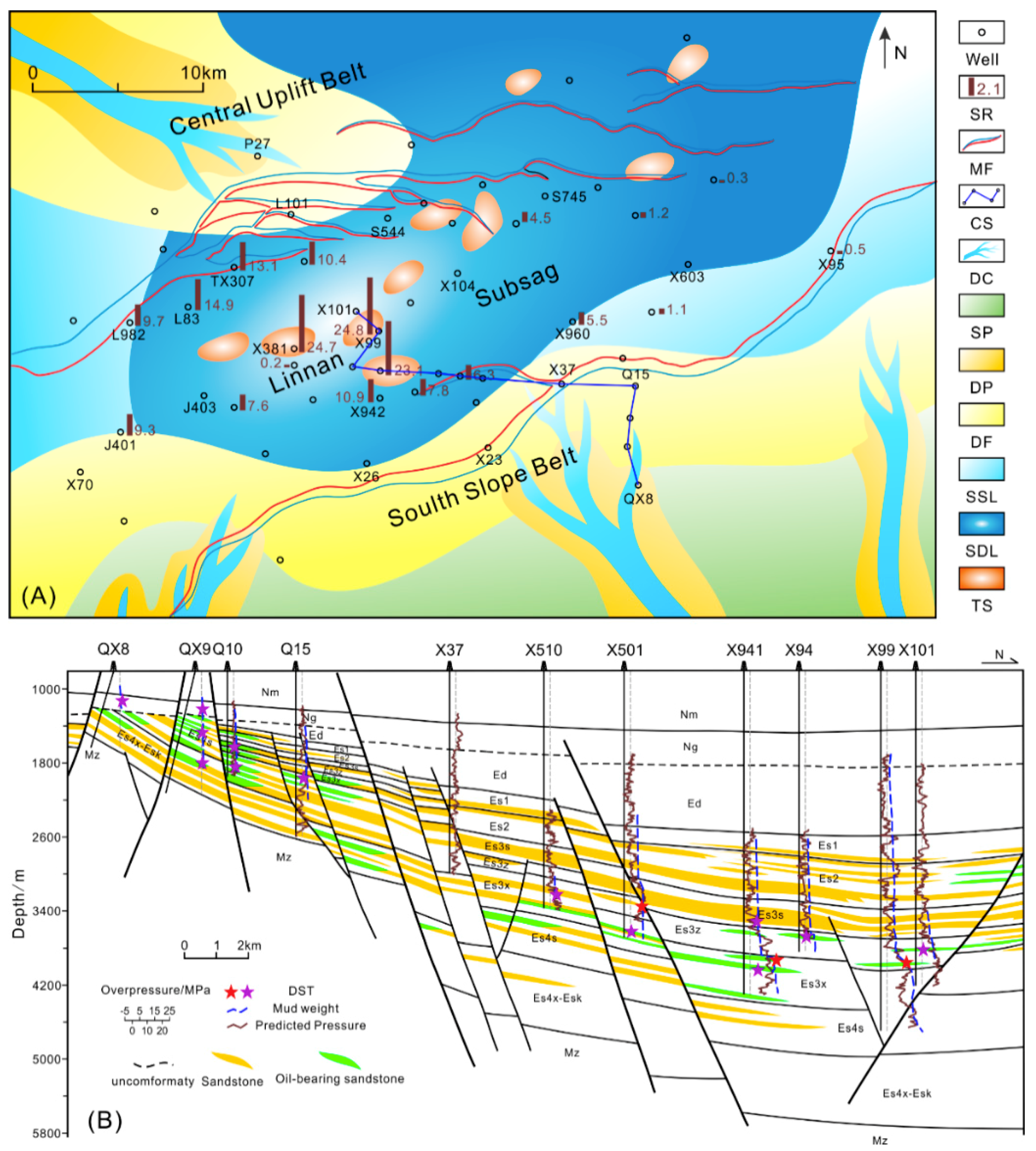
| Label | Well | Formation | Depth/m | PP/MPa | OP/MPa | PG/(MPa/km) |
|---|---|---|---|---|---|---|
| 1 | X941 | Es3x | 3978.98 | 62.91 | 23.12 | 15.8 |
| 2 | X381 | Es3x | 4007.8 | 63.96 | 24.68 | 16.0 |
| 3 | S92 | Es4s | 3714.5 | 51.65 | 15.24 | 13.9 |
| 4 | S548 | Es3z | 3814.46 | 52.21 | 14.37 | 13.6 |
| 5 | X99 | Es3s | 3896.00 | 50.61 | 14.02 | 13.5 |
| 6 | TX307 | Es3z | 4216.00 | 54.46 | 13.14 | 13.0 |
| 7 | L83 | Es3x | 4342.08 | 57.65 | 14.97 | 13.3 |
© 2019 by the authors. Licensee MDPI, Basel, Switzerland. This article is an open access article distributed under the terms and conditions of the Creative Commons Attribution (CC BY) license (http://creativecommons.org/licenses/by/4.0/).
Share and Cite
Li, C.; Luo, X.; Zhang, L.; Wang, B.; Guan, X.; Luo, H.; Lei, Y. Overpressure Generation Mechanisms and Its Distribution in the Paleocene Shahejie Formation in the Linnan Sag, Huimin Depression, Eastern China. Energies 2019, 12, 3183. https://doi.org/10.3390/en12163183
Li C, Luo X, Zhang L, Wang B, Guan X, Luo H, Lei Y. Overpressure Generation Mechanisms and Its Distribution in the Paleocene Shahejie Formation in the Linnan Sag, Huimin Depression, Eastern China. Energies. 2019; 12(16):3183. https://doi.org/10.3390/en12163183
Chicago/Turabian StyleLi, Chao, Xiaorong Luo, Likuan Zhang, Bing Wang, Xiaoyan Guan, Hongmei Luo, and Yuhong Lei. 2019. "Overpressure Generation Mechanisms and Its Distribution in the Paleocene Shahejie Formation in the Linnan Sag, Huimin Depression, Eastern China" Energies 12, no. 16: 3183. https://doi.org/10.3390/en12163183
APA StyleLi, C., Luo, X., Zhang, L., Wang, B., Guan, X., Luo, H., & Lei, Y. (2019). Overpressure Generation Mechanisms and Its Distribution in the Paleocene Shahejie Formation in the Linnan Sag, Huimin Depression, Eastern China. Energies, 12(16), 3183. https://doi.org/10.3390/en12163183





